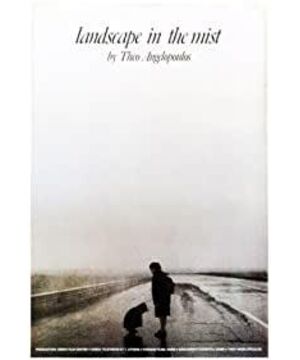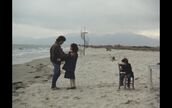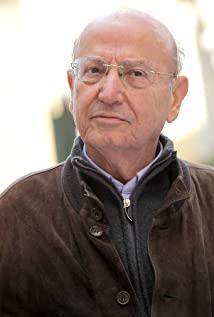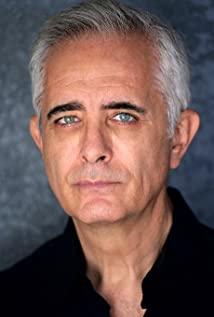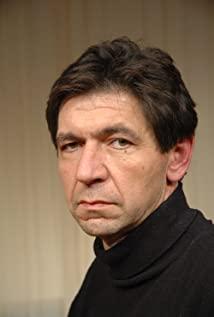"Obviously, [the moment] is here and there at the same time, and what I call "my present" is a foot on In the past, the other foot is stepping on the future."
-Matter and memory, Henry. Bergson
Angelopoulos slow? At a seminar in Tokyo ten years ago, the well-known film critic Jonathan Jonathan. Jonathan Rosenbaum also asked Ozu Yasujiro the same question, is Ozu slow? We know that this question is just a rhetoric. Whether it is in terms of the average number of seconds of the shot or the tension of the plot, he has presented various evidences to prove that Ozu is a "slow" director under quantitative analysis. (Please refer to David Bordwell's book: "Ozu and the Poetics of Cinema", http://0rz.tw/aTn0q can be downloaded here)
Back to Angelopoulos' subject, is he slow? Is it slower than Straub and Huillet, Kiarostami, Tarkovsky? It can even be said that "slowness" seems to have become a certain characteristic of modern movies. In Deleuze's vocabulary, the sensory dynamic function is broken after the Italian new realism, so that the image or montage is no longer a timely composition, connecting The image of is never the end of the previous image or the beginning of the next image. After the New Wave, movies entered the "modern" era, into the era of time-images. The confusion and questions brought about by modern movies often make the audience confused: Why do the protagonists in Gundam's "Band of Outsiders" suddenly dance? Why does the actor in "Vivre Sa Vie" suddenly look at Poe, translated by Baudler? Or in Tarkovsky, or even the recent Cai Mingliang, a lens has to be fixed somewhere for so long? There are various answers to these questions. However, compared to Tarkovsky’s fluid material touch, Straub’s dialectical counterpoint of sound and picture, and Cai Mingliang’s long shots to accumulate emotional tension, the initial question is definitely that the author thinks this Greek poet director is not at all. The reason is not slow. The reason is that the long shots in Angelopoulos's films are delicate and arranged. In the past two decades, no one can match it. This article intends to analyze Angelopoulos's gaze through an outstanding long lens of six minutes and ten seconds from 46:30 to 52:40 in "Landscape in the Mist". (This time is based on the third edition of Taiwan.)
First of all, I have to elaborate a little bit. In this scene, Alexander met the old man in "Voyage to Cythera" (Voyage to Cythera) in a restaurant playing the violin, and then in the evening After picking up almost blank foggy negatives on the road, before hitchhiking the truck where Vera was raped on the road again. We can even sketch the outline of the plot like this:
Embark on a journey-train-meeting with uncle after being caught, snowing-train-roaming the roads and towns, occasionally seeing a newlywed couple-meeting Orestes, restaurants, picking up negatives-meeting with wandering artists -Highway, hitchhiking-restaurant dispute-Vera was raped-train, road-meet again with Orestis, dance by the sea-wandering artists selling possessions, helicopters and statue hands, motorcycle market -Realizing that Orestis is gay, dancing halls and parting-Asking others for money in the railway station, the only safe train journey-Boating across the river, a foggy scenery
Angelopoulos said this film It is a journey that allows people to enter the beginning of life. On the journey we will see beauty and destruction. From a structural point of view, this passage of the film is the key to the two children’s transition from beauty (the hazy baroque condensation on the negative) to the destruction of their childhood dreams (Vera being raped). The part before this paragraph of the whole film is full of a sense of lightness and joy of embarking on a journey. Although a truth is revealed by the uncle in the middle, from the snow scene, the newlyweds, the restaurant to the few negatives, the protagonists Both are still alive. However, in the latter part of Vera's rape, wandering artist's costume auctions, and the disillusionment of Orestis in the ballroom, the shackles of history and reality were put on the protagonist one by one. When this paragraph is the middle point, we can draw a beautiful structure picture of "Landscape in the Fog" (the note at the back is the emotional tone of the paragraph):
Departure-
Uncle, the disclosure of the facts (evil) -Snow scenery (good)- Newlyweds (good)-violin and negatives (good)
meeting with vagrant artists-
raped (evil)-home auction (evil)-the disillusionment of Orestis-(evil)-good-hearted people's assistance (good)- Endgame
points out the structural importance of this passage, the second element to be introduced is the intertextuality based on its own shadow history. Angelopoulos likes to create an atmosphere of parallel universes in the movie:
From the protagonist name of Alexander through "Saisai Island Journey", "Alexander the Great" (Alexander the Great), "The Suspended Step of Stork" (The Suspended Step of Stork), "Scenery in the Mist" and other films, and Vera in "Saisai" "Journey to the Island" is also Alexander's sister, but "Sai" is like the reverse thinking of "Fog": What if the father we are looking for returns after decades? At the same time, the old man playing the violin appeared in the restaurant. Did Spiro’s wandering through time and space allow Alexander to meet his father as early as he was a child? (In terms of age surreal manipulation techniques, Alexander’s crossing in "Eternity and A Day" (Eternity and A Day) has more obvious performance in the moment and in the past.)
Another intertextual description appears in "Yuri" "Ulysses' Gaze" (Ulysses' Gaze) reveals the talk about the fog. The fog has a festive atmosphere in "Ulysses' Gaze," because it brings a truce, but it is not entirely a symbol of beauty. The Baroque style mentioned above means that the scenery cannot be seen in the fog. The scenery that is not depicted does not mean that it does not exist. In this way, the fog or the hidden figures create a kind of "frame". Inside and outside the frame." At the same time, this condensation also allows us to glimpse the long river of time in Angelopoulos' eyes. ("Landscape in the Mist" and "The Gaze of Ulysses" have similar scene treatments)
The third connection is that this wandering artist group has been struggling to make "Golfo The Shepherdess" a romantic tragedy that was extremely popular in ancient Greece since "The Travelling Players" (The Travelling Players). The performance was over, but was repeatedly interrupted. In "The Wandering Artist", the names of all the characters are derived from Aeschylus's "Orestia" trilogy (Agamemnon, Choephori, Eumenides). In a war situation. In this scene in "The Fog", the wandering artist plays various "personal names" of Greece in the wars of the 20th century under the patrolling of the camera for no reason. Roman Jakobson once said that there are no metaphors in movies, only metonymy. Rhetoric such as "hands flapping like wings" can only be achieved by the editing of two lenses in a movie. . But he misunderstood a formalist aesthetics, didn't he just emphasize the new meaning produced by the addition of the two lenses? After the 1960s, Gundam also realized the shortcomings of linguistically dominating movies. The scene scheduling can also play an effect like editing and escape from the linguistic stalemate. As Gundam said: "...Montage is mutual Relevance.” Going back to the question of historical person: Angelopoulos condensed a piece of history into a line on the stage through a series of actors (we can even say that this passage is a condensation of "The Wandering Artist"), but again A metaphor of the history of Greek turmoil is produced by the technique of one actor next to another.
Judging from the intertextuality of various texts, "The Shepherd Girl Golf" itself is a romantic tragedy (a good woman competes with a bad woman, and the bad woman wins, but then the man realizes that he goes back to find a good woman, but he has already drunk it. The death of the poison), "Orestia" is even more tragic, and the two dramas have already set the tone for the subsequent paragraphs. The reason why the romantic tragedy is included in this paragraph is also that the play symbolizes Vera's enlightenment to love (and sex afterwards). When the camera turned to the first one hundred and eighty degrees, the old woman on the chair called to the girl, saying how could a beautiful child's hair be so messy? Let the audience begin to notice Vera's feminine characteristics, which indirectly heralds the following paragraphs about rape.
Formally, in addition to the 360-degree rotating lens, the depth of field is also an important element: the various levels of the actor's station also bring out the emotional intensity of the character, such as the black-clothed actress who often crosses the camera. Anxiety, mostly in half-length shots. After the rehearsal was interrupted, the team leader ran to the foreground to make up. Judging from the size of the screen, it seemed to have an overwhelming advantage over the other team members. The most special thing is that the car that interrupted the rehearsal appeared unknowingly in the distance, quite interesting for fate to come. (As for the perfect symmetry in the structure, please refer to the analysis of the capture
in the appendix ) In the analysis of the capture in the appendix, we can see the dialectical relationship between the camera's perspective/the protagonist's perspective/free indirect discourse. At the beginning, the camera stopped on the two protagonists, and then the camera moved faster than the characters. After panning to the right, the actor began to make statements similar to inner monologues. The space of the picture was filled with the consciousness of splitting during the fifty years of war. , The character did not re-enter the screen until screen six. But the camera didn't wait for them. After the children ran to the old woman, they continued to patrol, changing the perspective of the audience to the audience in the theater, where each consciousness was unified. After the scene was over, the camera continued to pan to the right, and we saw the gathered actors spread out and walk towards the sea one after another. Finally, the camera stops when the two protagonists look at them. The purpose of using the long shot here is to highlight the dialectic between the presence and absence of the two protagonists, because the continuity of the long shot can also emphasize that the character is actually present, but the camera does not see him, as Bazin said. "The movie is our window to the world."
This kind of gaze reminds us of Angelopoulos’s "The Gaze of Ulysses" in 1995. His gaze started from "The Journey to Seth Island" or even an earlier film. This is also why he was going to remake the epic Odyssey again in 1995. As the poet sings his arguments and matters time and time again, we can’t tell who is Ulysses and Spiro. , Beekeeper, Sorrow Steppe), Alexander (Alexander the Great, landscape in the fog, bird-watching, eternal day) and Angelopoulos himself, because their vision is as analyzed in the previous paragraph, there is no need to distinguish subjective / Objective lens, and finally reach the realm of indirect free discourse. He was arrested and imprisoned in 1947, and he put on the rag because he was bored with the revolution. Because of this, Angelopoulos became the voice of Greece, wandering among the Greek city-states with his irrefutable compassion, narrating like a bard.
Finally, back to the beginning of Bergson. It is this kind of time-image that Deleuze praised in his Cinema 2 (Cinema 2). The discourse of history does not only need to put the moment into the surging torrent of history, we should have another way of thinking. Condensing the surging torrent of time and the memory of the past in one point, the past will exist in the moment at the same time, and will develop into the future. Time-image is not time, but it presents the dual direction of time, so what we see is only time. From metonymy to metaphor, we might say that Angelopoulos presents a kind of poetics-image.
Finally, we heard Alexander dream of his father, and then they set off.
View more about Landscape in the Mist reviews


